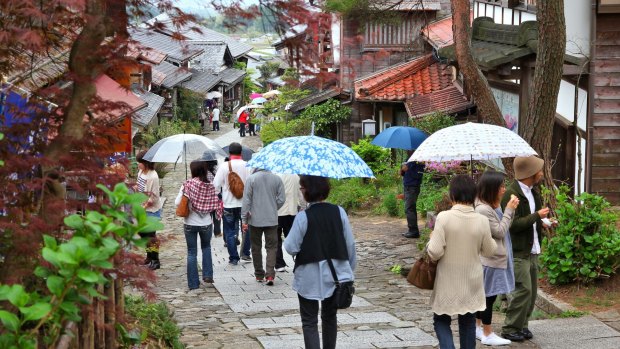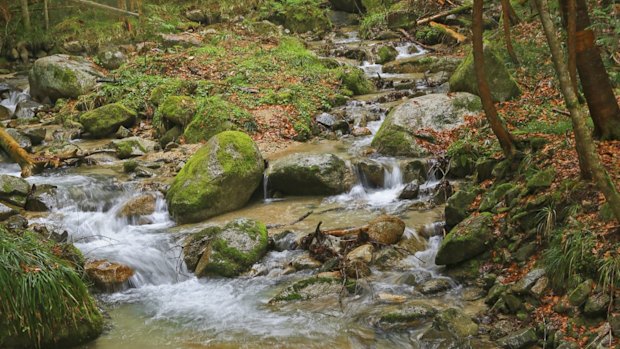This was published 7 years ago
Nakasendo trail, Japan: A historic trek through the heart of old Japan

People visit old town of Magome.
The driver is adamant. He's stopped the bus at the top end of Magome and now he wants me out. He's already got me figured for a walker – shoes, daypack, hat – and he's planed his hand to make a sharp ramp. If I get out at the top of Magome it'll save me a steep walk through the town is what he's telling me in mime but that's not the point. There are two other walkers on the bus, a Japanese couple, and they're not budging either. After a minute of nonverbal to and fro the driver shrugs, the bus sighs and we head off down the hill to the bottom end of Magome.
I'm setting out to walk a short section of the Nakasendo, one of the historic routes between Edo – modern-day Tokyo – and Kyoto. The Nakasendo began in the Edo period, the early 1600s, when the ruling Tokugawa Shogunate established itself in Edo while Kyoto remained the imperial capital. The Nakasendo, the road through the mountains, was one of the Five Roads, a network of links to enable the shoguns to maintain communication and control over their territories. Dotted along the Nakasendo were 69 post towns where messengers, monks, merchants and samurai could rest between each stage.
The section I'm walking is more properly known as the Kisoji, a much older trail than the Nakasendo, which runs through the mountainous Kiso region in the southeastern part of Nagano Prefecture. It's a gorgeous part of Japan, with peaks that rise to 3000 metres, mossy forests of cypress trees and patchy farms. When it was incorporated into the Nakasendo 11 post towns were set up along the Kisoji and I'm walking the 9km section between Magome and Tsumago. While most of the post towns have either disappeared or changed out of all recognition Magome and Tsumago are still powerfully evocative of the era in which they were built.

Waterfall and stones covered in moss, unspoiled nature at Nakasendo walking trail from Magome to Tsumago, Japan. Credit: Sasimoto
Magome is just stirring to life but right at the bottom of the town there's a coffee shop and pancakes with maple syrup to fortify me for the climb ahead. Magome is unashamedly a tourist town and at 10 on a Saturday morning I'm weaving on the stone-flagged path between merry groups of sightseers, all headed downward past shops selling souvenir hats and back scratchers and tasty treats. I stop at one and buy a bento box and some onigiri, rice balls wrapped in malachite-green nori with tuna inside.
The driver was right, it's steep. The town sits astride a ridge and the path is as often steps as it is stonework. The name Magome comes from the word "horse basket". Travellers had to take off their horses' baskets here and continue on foot since the trail through the town was too steep for laden horses.
Magome was comprehensively torched when a fire swept through in 1895 and although the present wood and plaster buildings date from the 20th century they faithfully mimic the style and architecture of the Edo period. On the left I pass the town's honjin, the official lodging where feudal lords once stayed, and the waki honjin, the overflow lodging. It wasn't just traders and pilgrims on the Nakasendo but also daimyo, Japan's feudal lords, and also its biggest landowners until well into the 1800s.
On the right a little further up is a reproduction of a kosatsuba, a Tokugawa notice board, with the local rules written on wooden tablets. Among them is a prohibition that warns against Christianity, another prescribes the reward for turning in a Christian. Jesuits had established missions in Japan as early as the mid-1500s, with inevitable friction with Buddhism and Shintoism, and the Tokugawa lords smelled danger. Another tablet prescribes the penalty for cutting down a cypress tree - death – since cypress was reserved for castles and the Grand Shrine at Ise.
There's a stall that brands travellers' staves. Dedicated hikers planning to walk the entire Kisoji can buy a wooden Kiso Post Towns Travelers Staff and at various points along the Kisoji you stop to get the local name seared into the wood.
I'm panting when I make it to the bus stop at the top of Magome, walking against an incoming tide of visitors, but as soon as I cross the road I'm all alone on a path that snakes into woodland.
For the next three hours the path laces through bamboo and cedar forests, playing hide-and-seek with white-bladed streams that add their music to the journey. There are watermills with churning wheels and cherry trees, maples with tiny leaves and lonely shrines, and Japan's animist Shinto creed prefers a forest setting for its devotions. Invisible birds serenade from the forest and the cool, damp air leaves glistening water pearls on my t-shirt.
One of the many notable figures associated with the Kisoji is Basho, the supreme master of the haiku. Basho travelled the Kisoji in 1685, one of several pilgrimages he made as an exercise in spiritual and artistic refinement.
So often seen off,
Or seeing you off, journey's end -
Autumn in Kiso
...was one of the haikus he wrote on this journey and if that makes more sense than the sound of one hand clapping, do let me know.
There's a yellow sign with a black bear on it and although I can't read the characters the meaning is plain enough. Japan has two bear species, the Asiatic black bear and the Ezo brown bear but any bear in these forests would be the black bear, which probably number around 10,000 in Japan. Omnivorous tree climbers, also known as moon bears for the white yoke on their chest, they're short tempered. It's not uncommon for someone in Japan to be killed by a black bear, and a surprised bear is a dangerous bear. I give the brass bell nearby a good clang.
The path, stone-lined for the most part, rises steadily until it reaches a village at Magome-toge, and crests the pass at 800 metres above sea level. Walkers are few. Although this particular stretch of the Kisoji is a favourite with hikers I encounter only half a dozen other hikers. Backwoods toilets are never something I look forward to but the ones on the Kisoji are beautiful, scrupulously clean and smelling of pinewood.
Down from the pass there's a sign on the side of a barn-like building that says "free tea" and "Wifi". Inside an elderly gent with parchment skin dressed in a black yukata manhandles a big kettle over an irori, a hearth set into the floor, in which a smoky fire is smouldering. As he doles out green tea he tells me the building is 300 years old and the smoke keeps the wood dry. He asks where I'm from and tells me more Aussies walk the Nakasendo than anyone else apart from Japanese themselves, with the Spanish in second place. "Que sera, sera," he says when he tells me this, and smiles.
The trail on this side of the pass is narrower and the Ishi-datami, the stone flagged pathway characteristic of the Nakasendo, has given way to a more agricultural version that threads between terraced rice fields and past boisterous waterfalls at Medaki and Odaki – female and male. A deserted building marks the spot where the feudal government maintained a checkpoint to prevent the illegal harvest of forest timbers. I'm getting wet. The clouds that halo the towering hills have begun leaking rain but I'm soon walking among the roofs of Tsumago.
Tsumago is celebrated as an outstanding example of an Edo-period townscape, the first town in Japan designated as a national Architectural Preservation Site. It almost didn't happen, and Tsumago could easily have shuffled off along the road to modernity, along with the other former post towns along the Nakasendo. Back in the middle of the 20th century, long after the Nakasendo had ceased to be a major artery, Tsumago was a wreck, its Edo-era houses collapsing and neglected. Then in 1968 the local residents joined together to restore the village, and signed a charter to ensure that no building would be sold, hired out or destroyed. Today it's an open-air museum but a living one and it's hard not to be seduced. The curving main street is lined with machiya houses, single-family dwellings with a shop at the front, residence behind and above. The wooden koshi lattice at the front of each shop indicates what type of goods would have been sold inside.
I'm staying the night and I'm tying not to drip when I enter Fujioto Ryokan, a traditional inn about halfway along the main street.
Franco, the owner, eminently Japanese but so named for the time he spent working in Italy, meets me at the door. "Bath time," he says, and there's a steaming cypress wood bath awaiting. An hour later, with flesh reddened from the hot water, I'm sipping warm sake and wearing a cotton yukata, looking out to the Fujioto's garden where koi carp are flickering in a pond, and feeling a little like a daimyo lord, in the mood for haiku.
The bamboo water
GETTING THERE
The closest train station to Tsumago is Nagiso. From Tokyo's Skinjuku Japan Rail Station, take one of the Limited Express Azusa services to Shirojiri and change to the Japan Rail Chuo train to Nakatsugawa, leaving this train at Nagiso Station. Taxis are available for the short journey to Tsumago. Other trains are available from Tokyo but they involve more changes. Travel time is about 4½ hours. From Kyoto, take any Shinkansen service to Nagoya then take the Limited Express (Wide View) service to Nagiso. Travel time is about 1 hour 40 minutes. See hyperdia.com/en.
STAYING THERE
Fujioto Inn is one of several lodgings in Tsumago and the owner speaks fluent English, making it a logical choice for visitors who want to sample genuine Japanese accommodation and cuisine. From about $140 per person per night, including breakfast and dinner. See tsumago-fujioto.jp
Michael Gebicki travelled at his own expense.
Sign up for the Traveller Deals newsletter
Get exclusive travel deals delivered straight to your inbox. Sign up now.